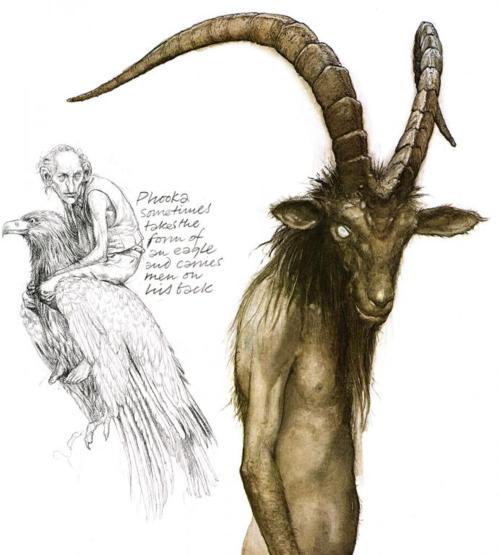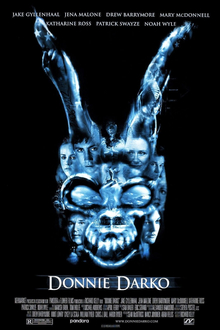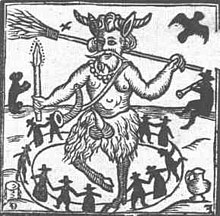 |
| Arthur Rackham, A Midsummer Night's Dream 1908 |
William Shakespeare's use of Puck in his famed play A Midsummer Nights Dream, is perhaps the most well known. In the play Puck does an excellent job describing just who he is.
FAIRY
Either I mistake your shape and making quite,
Or else you are that shrewd and knavish sprite
Called Robin Goodfellow. Are not you he
That frights the maidens of the villagery,
Skim milk, and sometimes labour in the quern,
And bootless make the breathless housewife churn,
And sometime make the drink to bear no barm,
Mislead night-wanders, laughing at their harm?
Those that Hobgoblin call you, and sweet Puck,
You do their work, and they shall have good luck.
Are you not he?
PUCK
Thou speakest aright;
I am that merry wanderer of the night.
I jest to Oberon, and make him smile
When I a fat and bean-fed horse beguile,
Neighing in likeness of a filly foal;
And sometime lurk I in a gossip's bowl
In very likeness of a roasted crab,
And when she drinks, against her lips I bob
And on her withered dewlap pour the ale.
The wisest aunt, telling the saddest tale,
Sometime for three-foot stool mistaketh me;
Then slip I from her bum, down topples she,
And 'tailor' cries, and falls into a cough;
And then the whole quire hold their hips and laugh,
And waxen in their mirth, and neeze, and swear
A merrier hour was never wasted there.
-- A Midsummer Night's Dream, Act II, scene i
Puck is described as a Hob-Goblin, creatures who participate in frequent mischief. Goblins are known to be malicious beings, often cruel and benevolent in the same night. The term Goblin can refer to uglier types of Faerie, not quite the glamorous light-being that the imagination conjures.
 |
| Faeries, Brian Froud & Alan Lee 1978 |
In etymology Puck stems from the Welsh pwca or pooka. The Phooka can be spelled many ways as his existence translates to multiple cultures: púca (Irish for spirit/ghost), pooka, phouka, phooka, phooca, puca or púka. He is predominantly associated with Celtic lore, a shape-shifter, the only one of it's kind who is able to communicate with both animals and mortals. He can appear as various creatures including goblins, dogs, goats, horses and even birds. In most circumstances his fur will always remain dark black.
In old Celtic legends he traditionally appears as a dark horse with piercing golden eyes. Mortals who are beckoned to the creature, are often lured to ride upon it's back. Once upon the horse they are taken on a terrifying hell-ride through the dark night until they are ejected into the mud or within a ditch, where-after they are subject to hearing strange laughter as the creature disappears back into the mist. (Unlike the malevolent faerie creature called a Kelpie, who leads their riders to a quick demise by diving into a river to drown and the consume them.) In legend he is the cause for illness associated with eating overripe blackberries.
While frightening in his traditional cultured definition, the Phooka is also at times quite benevolent, offering advice to those who seek it. In many tales the Phooka is helpful to farmers bringing wealth and prosperity, this is where he is most surely tied to Puck & Hobgoblins, as not all goblins are strict in their mischief.
 | |
Arthur Spiderwick's Field Guide to the Fantastical World Around You,
|
 |
| Universal Pictures 1950 |
Harvey, a beloved 1950's feature film staring Jimmy Stewart, is perhaps one of the most unusual appearances of the Phooka. In the film Stewart's middle aged character Elwood P. Dowd is viewed suspiciously as he attests openly to having a friend in the form of a six-foot, three-and-one-half-inch tall invisible rabbit. His family and friends doubt his belief and challenge his sanity before succumbing to their own realization that he is perhaps telling the truth. At one point in the film Elwood shares the true identity of the rabbit as that of a Phooka.
 |
| Pandora Cinema & Newmarket Films 2001 |
In 2001 a film titled Donnie Darko debuted staring Jake Gyllenhaal. In the tradition of Harvey the title character Donnie is tormented by an invisible dark bunny-rabbit, who at times seems both malevolent and benevolent. At the beginning of the film Donnie is shepherded away from death by the rabbit, a traditional action of the Phooka. Although 'Frank' the rabbit is written off as a waking hallucination, it can be inferred that his traits and peculiar behaviors are associated directly to the Phooka. Donnie Darko has quickly fallen into a sub-cuture of cult film in part because of the mystical frightening and esoteric presence of the Phooka.
 | |
| Robin Goodfellow: His Mad Pranks and Merry Jests (1629) |
The medieval depiction of Puck describes a half goat, half man with cloven hooves and horns. Resembling a satyr, Puck is perhaps the English evolution of the Grecian horned god of the wood called Pan.
*For any who are interested in further reading, this post was aided by a variety of fantastical sources:
- The Enchanted World Series by Time-Life Books, 1980's
- Faeries by Brian Froud & Alan Lee, Abrams/Rufus Publications, Inc. 1978
- Faeries and Demons and Other Magical Creatures by Edouard Brasey, S.A. Démons & Merveilles, Barnes & Noble Books 2002
- Arthur Spiderwick's Field Guide to the Fantastical World Around You by Tony DiTerlizzi & Holly Black, Simon & Shuster 2005
- The New Merriam-Webster Dictionary
- Wikipedia
Wonderful information. Very interesting.
ReplyDelete